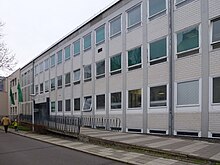Pharous halls
The Pharussäle were an event center on Müllerstrasse in Berlin's Wedding district . The halls in the middle of the Red Weddings were known as the KPD's “second living room” .
History and description
The halls were built in 1907 as the successor to the Feldschlösschen from brewery owner Wilhelm Bönnhoff , a large beer garden with a theater and concert hall that had fallen victim to the construction of the Brussels neighborhood in Wedding.
The Pharus halls consisted of a residential building facing the street and a building at the rear that accommodated the event halls on two floors. The new halls could hold up to 2,500 people. Celebrations of all kinds took place there, from private celebrations to celebrations for the emperor's birthday by the congregation of the Kapernaum Church . The premises were used for political events at an early stage. There, the SPD met regularly with Karl Liebknecht , who was active in Wedding and who used the halls as an alternative location, since open-air political events were forbidden in the German Empire. Notable events that took place here were, for example, the celebrations when Liebknecht was elected member of the state parliament in 1908, or the celebrations when he was released from prison in 1909.
After the advent of the KPD , which had a stronghold in Wedding, it increasingly used the halls for its own events. The 12th party congress took place here around 1929, at which Ernst Thälmann , Walter Ulbricht and Wilhelm Pieck , among others , were re-elected to the Central Committee. This was the last legal party congress of the KPD. It was also memorable because Thälmann publicly spread his thesis of the social fascism of the SPD here.
The NSDAP also made its first major public appearance in the halls. Joseph Goebbels , who was newly appointed to Berlin as Gauleiter , rented the hall for February 11, 1927 as a symbolic location for the “Reds” to show their presence here. As expected, the performance ended in a street battle with many seriously injured.
After the NSDAP came to power, they gave notice to the Jewish tenant of the halls. In the Pharus halls, rather non-political events - from small animal exhibitions to operetta evenings - took place. From 1940, a large canteen was set up in the halls to cater for people in need. The swing youth is said to have used the building for forbidden swing and dance evenings.
The halls were destroyed in the war in 1945 and completely demolished in 1955. In their place, Hertie built a department store based on plans by Hans Soll , which in 1998 had to give way to a shopping center. One of a total of 90 West Berlin outpatient clinics was also built on the property in 1960 - bases for various specialists at one location. After the doctors resident in West Berlin condemned the concept of the outpatient clinic as "communist", they enforced the closure of all outpatient clinics. Only that in Wedding remained as it was directly sponsored by the AOK , which did not give in to political pressure.
Individual evidence
- ↑ a b c d Gerhild H. M- Komander: Der Wedding: on the way from red to colored Berlin Story Verlag, 2006 ISBN 3-929829-38-X p. 113.
- ↑ a b c d e f Eberhard Elfert: The Pharussäle . In: Roter Wedding , 2013; accessed on November 16, 2015.
Coordinates: 52 ° 32 ′ 53.8 " N , 13 ° 21 ′ 16.5" E

